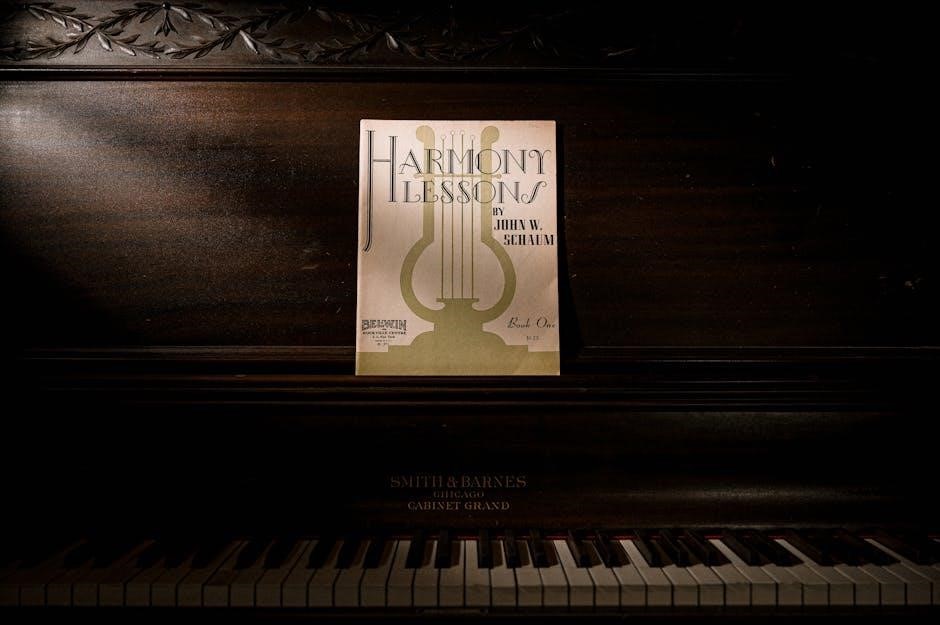Learning piano as a beginner requires proper resources like PDF books for structured guidance. These books offer step-by-step lessons, covering hand positions, notes, scales, and chords, helping build a strong foundation and keeping learners motivated.
1.1 The Importance of Proper Resources for Beginners
Proper resources are essential for piano beginners, as they provide structured guidance and a clear learning path. High-quality piano books in PDF format offer step-by-step instruction, covering fundamental concepts like hand positions, note reading, and basic techniques. These resources are particularly valuable for self-learners, as they replace the need for constant teacher supervision. With a well-organized PDF book, beginners can progress at their own pace, ensuring they grasp essential skills before moving forward. Free and easily accessible, these materials often include exercises, songs, and practical tips, making learning both enjoyable and effective. They also help build confidence and motivation, which are critical for consistent practice and progress.
1.2 Benefits of Using a Piano Book in PDF Format
Using a piano book in PDF format offers numerous advantages for beginners. It provides easy accessibility, as PDFs can be downloaded instantly and accessed on various devices like tablets, laptops, or smartphones. This portability allows learners to practice anywhere, making it ideal for busy schedules. Additionally, PDF books are often cost-effective, with many high-quality resources available for free or at a lower cost than physical books. They also enable easy navigation, with features like bookmarks and search functions to quickly locate specific lessons or concepts. Plus, PDFs can include interactive elements, such as audio clips or links to video tutorials, enhancing the learning experience. This format ensures that beginners have all the tools they need in one convenient and flexible package, promoting consistent practice and skill development.

Foundations of Piano Learning
Laying a strong foundation is crucial for piano learning. Understanding the piano’s layout, proper hand positioning, and basic posture sets the stage for mastering techniques and music theory effectively.
2.1 Choosing the Right Digital Piano or Keyboard
Selecting the right digital piano or keyboard is essential for effective learning. A full-sized 88-key instrument with weighted keys is ideal, as it mimics an acoustic piano’s feel. Touch sensitivity ensures expressive playing, while built-in speakers provide clear sound. Look for essential features like metronome, recording capabilities, and USB connectivity for versatility. Additional sounds and rhythms can enhance practice but aren’t necessary for beginners. Portability and budget are key considerations—keyboards with stands and pedals offer better value. Research brands like Yamaha, Casio, or Roland, known for quality and durability. Reading reviews and comparing models will help you make an informed decision tailored to your needs and budget.
2.2 Understanding Basic Piano Concepts: Notes, Scales, and More
Mastering basic piano concepts is crucial for beginners. Start with understanding notes, which are the building blocks of music. Notes can be natural, sharp, or flat, and their values (whole, half, quarter, etc.) determine duration. Scales, such as the C Major scale, introduce finger placement and musical structure. The staff consists of five lines and four spaces, with clefs (treble and bass) guiding note placement. Learn note names (A-G) and their positions on the keyboard. Rhythm and tempo are also vital, as they dictate the timing and speed of playing. Practicing scales and arpeggios improves dexterity and familiarity with the keyboard layout. These foundational concepts are essential for progression and should be reinforced through consistent practice and review.

Effective Learning Approaches
Explore structured practice routines, goal-setting strategies, and interactive tools to enhance piano learning. Consistency and technology can accelerate progress for beginners. Stay motivated and engaged with diverse methods.
3.1 Popular and Effective Learning Methods for Beginners
Beginners can benefit from structured methods like the Suzuki Method, which emphasizes ear training and parental involvement. The Alfred’s Basic Piano Library is a popular choice, offering a comprehensive approach to reading music and technique. The Hal Leonard Student Piano Library is another widely-used resource, known for its engaging and progressive lessons. Additionally, interactive methods such as video tutorials and app-based learning complement traditional piano books. Many beginners also find success with the “play-by-ear” approach, which builds musicality before focusing on sheet music. Combining these methods with consistent practice and achievable goals ensures steady progress. Using a piano book in PDF format provides flexibility and accessibility, making it easier to follow these methods anywhere.
3.2 Top Piano Learning Apps for Beginners
Several apps are designed to make piano learning fun and accessible for beginners. Piano Maestro is a top choice, offering interactive lessons and exercises aligned with piano method books. Simply Piano by JoyTunes provides step-by-step lessons and real-time feedback. Yousician combines gaming elements with piano lessons, making practice engaging. Piano Game focuses on developing hand coordination and rhythm through interactive exercises. Fender Play also includes piano lessons alongside guitar, with a user-friendly interface. These apps often complement traditional piano books in PDF format, offering a modern, mobile way to learn. They are ideal for self-paced learning and can be used alongside a digital piano or keyboard for optimal progress.

Reading Sheet Music
Reading sheet music is essential for beginners, providing a visual guide to notes, rhythm, and timing. It helps build foundational skills for piano learning and mastery.
4.1 How to Read and Understand Sheet Music
Reading sheet music is a fundamental skill for piano beginners. Start by familiarizing yourself with the staff, consisting of five lines and four spaces, where notes are placed. Notes vary in shape and position, indicating pitch and duration. Whole, half, quarter, and eighth notes represent different timing values. Rests signify silence and are essential for rhythm. Clefs, such as the treble or bass clef, determine the pitch range. Time signatures guide the rhythmic structure, while dynamics like piano (soft) and forte (loud) add expression. Articulations, like legato or staccato, influence how notes are played. Understanding these elements helps beginners interpret and perform music accurately and confidently.
4.2 Websites for Downloading Free Sheet Music
Several websites offer free sheet music for beginners, making it easier to practice and learn. MuseScore is a popular platform with a vast library of user-uploaded and community-created scores. Sheet Music Archive provides a wide range of classical and modern pieces. Piano Society specializes in piano music, offering high-quality sheets for various skill levels. Free-Scores features an extensive collection of free and premium sheet music. Additionally, IMSLP is an excellent resource for classical music scores. These websites are ideal for beginners looking to expand their repertoire without cost.

Techniques and Practices
Mastering techniques like finger exercises, scales, and arpeggios is essential for building dexterity. Regular practice routines and understanding pedaling techniques can enhance your performance and control.
5.1 Understanding Piano Pedals and Their Functions
The piano pedals are essential tools for enhancing sound and expression. The sustain pedal (right pedal) sustains notes, creating a resonant sound. The sostenuto pedal (middle) sustains selected notes, useful for complex passages. The soft pedal (left) reduces volume and softens the tone. Proper use of pedals can transform your playing, adding depth and emotion to your music.
A high-quality piano book in PDF format often includes detailed explanations of pedal functions, with exercises to practice their use. These resources help beginners understand when and how to apply each pedal effectively, ensuring their playing sounds polished and professional from the start.

5.2 Effective Practice Techniques for Rapid Progress
Consistent practice is key to mastering the piano. Set a daily routine, even for short periods, to build muscle memory. Start with scales and exercises to warm up, then focus on specific pieces. Break complex sections into smaller parts and practice slowly before increasing speed. Use a metronome to improve timing and rhythm.
A piano book in PDF format often includes structured lessons and exercises tailored for progressive learning. It guides beginners through effective techniques like hands-separate practice, finger independence exercises, and gradual tempo increases. By following these methods, learners can achieve steady improvement and enjoy a rewarding musical journey.
5.3 Essential Exercises for Building Skill and Dexterity
Elevate your piano skills with targeted exercises designed to enhance dexterity and coordination. A piano book in PDF format often includes finger independence exercises, scales, and arpeggios to strengthen hand muscles. Begin with Hanon exercises or simplified versions to improve finger dexterity and accuracy. Practice chromatic scales to expand your technical range and control. Incorporate exercises like finger stretches and trills to build agility and precision. These exercises, often outlined in structured PDF guides, provide a clear path to mastering foundational techniques. Regular practice of these exercises will enhance your ability to play complex pieces with confidence and fluency. Consistency is key to developing the skills needed for advanced piano playing.

Building Your Repertoire
Start with simple songs like “Twinkle, Twinkle, Little Star” and gradually explore various styles. A piano book in PDF format often includes a curated selection of beginner-friendly pieces to help expand your musical range and confidence.
6.1 Easy Songs to Play for Beginners
Starting with simple songs is crucial for building confidence and skill. A piano book for beginners in PDF format often includes classic pieces like “Mary Had a Little Lamb,” “Chopsticks,” and “Ode to Joy.” These songs require minimal notes and finger movement, making them ideal for newcomers. Additionally, popular children’s songs such as “Happy Birthday” or “Twinkle, Twinkle, Little Star” are great for practicing basic melodies. As you progress, you can explore simple arrangements of favorite pop or movie themes. These songs are designed to be achievable, helping you develop finger dexterity and rhythm while keeping the learning process enjoyable and rewarding. A PDF book typically organizes these pieces in a logical sequence, ensuring steady improvement.
6.2 Tips for Learning and Mastering Simple Melodies
Mastering simple melodies requires patience and consistent practice. Start by breaking the melody into smaller sections and practicing each part slowly. Use a metronome to maintain a steady tempo and improve timing. Focus on finger placement and hand position to ensure proper technique. Begin with the right-hand melody first, then gradually incorporate the left-hand accompaniment. A piano book for beginners in PDF format often includes exercises to strengthen finger independence and coordination. Practice daily, even for short periods, to build muscle memory. Listen to recordings of the melody to develop your ear and mimic the phrasing. Celebrate small progress to stay motivated and gradually increase the difficulty as you become more confident.

Staying Motivated
Set achievable goals, celebrate small victories, and reward progress. Find a practice buddy or share achievements online. Track improvement with recordings to stay inspired and committed to learning.
7.1 Tips and Tricks to Keep You Motivated
Staying motivated while learning piano can be challenging, but there are effective strategies to maintain enthusiasm. Set achievable goals, like mastering a new song or technique weekly, and track progress in a journal. Reward yourself for milestones, such as treating yourself to a new songbook or accessory. Incorporate music you love into practice to keep sessions enjoyable. Establish a consistent routine, even if it’s short, to build a habit. Use positive reinforcement by celebrating small victories, like flawless performances or improved finger dexterity. Additionally, explore interactive tools or apps that make learning engaging. Finally, remind yourself of the joy piano brings—consistent practice leads to lasting satisfaction and the ability to share music with others.

Additional Tools for Success
Utilize online resources, video tutorials, and interactive apps to enhance learning. Tools like metronomes and recording software help improve timing and track progress efficiently while practicing.
8.1 AI and Digital Tools to Enhance Learning
AI and digital tools are revolutionizing piano learning, offering personalized feedback and interactive lessons. Apps like Piano Maestro and Yousician use AI to track progress and provide real-time corrections, ensuring proper technique. Virtual piano simulators allow beginners to practice without an instrument, while AI-generated exercises adapt to skill levels. These tools complement traditional PDF piano books by offering flexibility and engagement. They are especially useful for self-learners, as they simulate a teacher-like experience. Additionally, AI-powered metronomes and rhythm trainers help improve timing and coordination. By integrating these tools, learners can accelerate their progress and enjoy a more dynamic learning experience alongside their PDF resources.

Consistency and dedication are key to mastering piano. A PDF piano book for beginners offers structured learning. Explore free resources for the best start to your musical journey.
9.1 Final Thoughts on Learning Piano
Learning piano is a rewarding journey requiring dedication and consistent practice. A piano book for beginners in PDF format offers structured lessons and accessibility, providing a clear path to understanding notes, scales, and techniques; It serves as a valuable resource for building a strong foundation. Exploring free resources can enhance your learning with various exercises and songs. Progress may be slow, but persistence leads to mastery. Stay motivated by setting achievable goals and celebrating small successes. Enjoy the process, embrace the joy of making music, and share your progress with others. With the right tools and mindset, you can achieve your musical goals. Happy playing!
9.2 Where to Find the Best Free Resources
Discovering high-quality free resources for piano learning is essential for beginners. Websites like Musicnotes, Sheet Music Archive, and MuseScore offer a variety of free PDF sheets and guides tailored for novices. Additionally, platforms such as Piano Marvel and Piano Nanny provide structured educational materials. YouTube channels often share complimentary PDF guides to accompany their tutorials. For classical pieces, IMSLP hosts a vast library of public domain music. Exploring these sites ensures you have access to diverse learning tools without cost. Remember to verify the accessibility and quality of resources to enhance your learning experience effectively.
